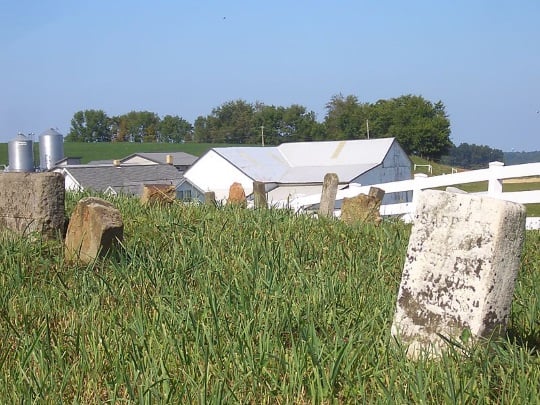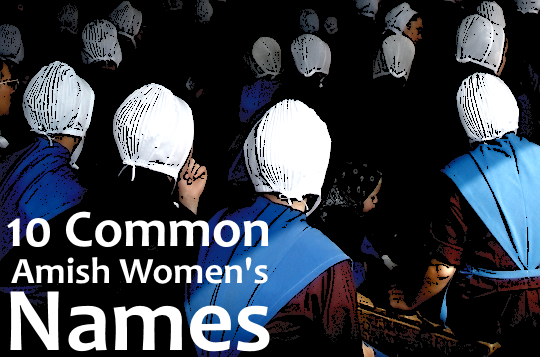Amish Funeral Traditions: The Viewing, Service & Burial
What are Amish customs regarding funerals – specifically the viewing, service, and burial?
It’s a somber topic, but in the latest Amish Cook column, Dorcas Raber, mother of regular columnist Gloria Yoder, steps in to describe Amish funeral traditions.
I’ve been to an Amish funeral, and also a viewing in a separate instance, though have not gone for the burial. I shared my observations on the funeral here.
Ohio Amish church member Rebecca Miller has also given her account of funeral customs in the Holmes County community here.

I’ve quoted rather liberally here, but I recommend reading the full column. I like the Amish Cook columns as they offer both a “slice of Amish life” – but beyond just sharing, say, the goings-on of a typical day, they also often give information on Amish culture, beliefs, and traditions.
In this column, Dorcas describes the funeral of her uncle Paul, who passed away at age 74 from cancer, leaving behind his wife Naomi and six adult children.
They traveled 400 miles to the “home place” where Paul had lived all his life, and where the funeral was held. It’s unclear which community that is.
It should be noted funeral customs can vary. Gloria Yoder is a member of a New Order Amish church. That doesn’t mean that this was necessarily a New Order funeral, however.
The Viewing
First, what happens at the viewing?
We arrived at 4 p.m. to attend the viewing and there was a line that was slowly moving. The viewing, which was in its second day, was held in a shop with rows of benches and chairs set up for family and friends.
Right next to the casket was Naomi and all of her six children and their partners. How they had loved and appreciated him. They have precious memories of taking care of their Dad the last weeks. In fact, the night prior to his death, all six children had been there. At such a time, family ties become all the more sweet and strong.
After we went through the line, we sat down for supper, which was being served to 175 people by the local church. It was delicious and included hobo stacks, brownies and ice cream. So many people came out to show their love and sympathy to the grieving family.
One of the most memorable parts of the evening was when a group of 30 youth gathered together and sang six songs. It was so lovely. “Amazing Grace “ was sung as well as songs about heaven.
Like a church service or other gathering, the viewing is held in a shop, basement, or other space at the home.
When I attended a viewing (in the Holmes County community), I had the impression of it being a social event as well as a time to remember and commemorate the deceased person’s life.
Food is important at any Amish event and the gatherings surrounding a funeral are no different. Uplifting hymns help those facing loss think on higher things.
The Funeral Service
Then, the funeral service, in a familiar place:
The next morning, the funeral was in a large machinery shed. It seemed fitting to have a dairy odor drifting into the shed; Uncle Paul had been a dairy farmer all his life. Hundreds of people filed in and the shed overflowed. More benches were set up right outside the shed opening. Rows and rows of women were in front of me, rows of black dresses and white head coverings. Close to the middle of the shed was the casket with the immediate family next to it. Three ministers each took a turn to comfort, exhort and encourage us as a congregation. One of my favorite parts of the sermons was likening Paul’s death to a ship on an ocean. When he passed away, friends and family said: “there he goes.“ But, yonder on the other side on the Heavenly shore, he is welcomed with “there he comes!”
After the sermons, the obituary was read. Paul and Naomi had been married for 49 years. Years of ups and downs, bumps and blessings, trials and tears but held together with love for God and one another. Indeed, they were blessed and were a blessing. This blessing lives on in the lives of their children and grandchildren as well as to others.
After the service, there is a final viewing:
Next, we all filed past the casket for one final viewing.
Meanwhile, a group of friends had gathered and sang three songs. To me, the loveliest one was the German version of “how beautiful heaven must be.”
At the very last, the immediate family gathered together around the casket for the final farewell — at least for this side of eternity. For in Heaven, we will never say goodbye. Four young men from the local church carried the casket out to the horse-drawn hearse.
The casket is typically a very simple pine box. A local Amish person may be responsible for making the community’s caskets.
The Burial
In this case, there is singing at the graveside, followed by a final prayer:
At the graveyard, the minister shared several thoughts, and several more songs were sung. The first one was “Goodnight, My Beloved.” This song is sung at most every Amish gravesite funeral. Next, the family was singing “that will be my last long move I’ll have to make,” and many others joined in. Slowly, the casket was lowered and then many hands helped cover the grave. At the very last, there was complete silence as everyone quietly prayed and said the Lord‘s Prayer.
This was followed by a lunch for everyone.
The book The Amish Way: Patient Faith in a Perilous World has very good in-depth discussion of Amish funeral customs and beliefs. From page 175:
Death in Amish society has not been sanitized or segregated from daily life. Members of the family touch and dress the body. Children are exposed to the reality of death many times before they reach adulthood. Church members dig the grave and cover the coffin with dirt. Death is received in the spirit of Gelassenheit, the ultimate surrender to God, as the community reflects on the familiar words of a hymn they have sung since childhood:
Consider man! The end,
Consider your death,
Death often comes quickly;
He who today is vigorous and ruddy,
May tomorrow or sooner,
Have passed away.
Some Amish, notably those of New Order churches, believe in assurance of salvation. But more often Amish speak of a “living hope” that their deceased loved one is with the Lord in heaven.







Gravesite
Why do Amish not publish obits in local newspapers? Are Amish buried next to their family ? Where are Amish cemeteries located and is burial allowed on their property?
You will actually sometimes see obituaries of Amish people in the newspaper (at least online and I assume in the physical copies as well), at least in some settlements (I have seen them for Lancaster County, for example).
#2 is a good question – I am not sure about the custom for how people are buried in the cemetery – whether it is grouped by family or perhaps by order of death. I will check and let you know what I find out.
The cemeteries are typically located on a plot of land, often sectioned out from a field of an Amish farm. You can see an example of one in Holmes County, Ohio, in the third photo down on this page (white picket fence surrounding it): https://amishamerica.com/holmes-county-ohio-photo/
The Budget newspaper from Sugarcreek, Ohio, publishes many obituaries of Amish people. In the Local Edition, which has general community news of Holmes/Tuscarawas/Coshocton Counties, there usually are several obituaries of Amish and non-Amish. In the National Edition of The Budget, there are usually several obituaries of Amish (and Mennonite) people from settlements in various parts of the U. S. I also enjoy reading the “In Memoriams” section in The Budget where relatives send in poems in memory of deceased loved ones. Many of these poems are original, sharing specific memories of their loved ones in poetic form.
This post was interesting and I enjoyed reading Rebecca Miller’s previous article about an Amish funeral. In it she mentioned at that funeral, there were so many people who attended, that the funeral service needed to be held in two buildings. In accounts of Amish funerals in The Budget, I have sometimes read about such large crowds that the service needed to be held in three buildings/settings, with several different ministers conducting the services.
Thanks for pointing that out, Al, I didn’t even consider “Amish” papers here, was thinking more of conventional “English” papers, but good that you mentioned the Budget. Would be interested to hear how common it is in other conventional papers – I just see obits from time to time pop up on the Amish news feed, and those tend to be Lancaster and larger communities. The person’s name will be traditionally Amish, and there will be mention that the deceased was a member of the Old Order Amish church.
Burial
Hi Erik, I do see obituaries for the Amish in the local Ohio newspaper. Usually there will NOT be a photo of the deceased but the obituary itself will usually tell which church they belonged to. (Old Order, New Order and I have seen some that just say Amish church) Most of the time it will state the name of the funeral home responsible for preparing the body, and it will state the name of the residence where the viewing is to take place. If you have ever stayed at the Carlisle Inn in Walnut Creek and you have a room on the backside of the hotel you can look out across the land and see 3 or 4 areas where there is a tree enclosed by a white fence. I am thinking these are small Amish cemeteries.
Love getting your e mails.
Sermon quote
The quote about the ship leaving the shore is from “A Parable of Immortality “ by Henry Van Dyke. This was read at several family services.
Thank you for sharing the source...
I first encountered this poem in 1992–in a booklet prepared by Hospice, provided to us during my stepfather’s last days. He truly loved the ocean and it seemed so fitting… and I have recited it many times since for it provides a wonderful perspective, urging us to understand there is often another side which we may not see.
Parable of Immortality Poem
I second Walter’s thanks Barbara! Below is the poem for anyone who is interested.
Apparently it is also known as “Gone From My Sight”, and was supposedly written by Luther F. Beecher, but is often mistakenly attributed to Van Dyke, at least according to Wikipedia:
“Gone From My Sight,” also known as the “Parable of Immortality” and “What Is Dying” is a poem (or prose poem) presumably written by the Rev. Luther F. Beecher (1813–1903), cousin of Henry Ward Beecher and Harriet Beecher Stowe. At least three publications credit the poem to Luther Beecher in printings shortly after his death in 1904.[1]
However, it is often attributed to Henry Van Dyke, probably due to his name appearing as the author in a widely distributed booklet by Barbara Karnes entitled “Gone from My Sight.”
https://en.wikipedia.org/wiki/Gone_from_my_sight
Parable of Immortality
I am standing upon the seashore.
A ship at my side spreads her white sails to the morning breeze,
and starts for the blue ocean.
She is an object of beauty and strength,
and I stand and watch her until she hangs like a speck of white cloud
just where the sea and sky come down to mingle with each other.
Then someone at my side says: “There! She’s gone!”
Gone where? Gone from my sight – that is all.
She is just as large in mast and hull and spar as she was when she left my side,
and just as able to bear her load of living freight
to the place of her destination.
Her diminished size is in me, and not in her.
And just at the moment
when someone at my side says: “There! She’s gone!”
there are other eyes that are watching for her coming;
and other voices ready to take up the glad shout:
“There she comes!”
Amish funerals
As a funeral director, and as someone fascinated with Amish culture, I am always interested in reading about Amish funeral customs. We have no Amish in our immediate area, so I am not able to help conduct funerals for the Amish, but I do know a funeral director in Lancaster County, PA, who serves the Amish in his area. And, my Amish friends in PA and OH often ask me about our “English” funeral customs when we visit.
Amish Family Occasions
Hi, this was very interesting and touching. I think it’s awesome to have the funeral at home rather than the sometimes sterile setting of a funeral ‘home’. I grew up in Kentucky and I remember some older (non-Amish) people talking about having wakes and visitation at their homes. I’ve also read accounts of funerals in Amish fiction and saw the funeral scene in ‘Witness’ but not sure how true they are (although the ‘Witness’ one seems pretty close).
I’m getting ready to make my annual trek to Holmes County next week and I remember last year in early October passing a yard set with white tents and what I took to be preparations for a wedding. Isn’t this getting to be the traditional time of year for weddings, or do they still stick to that? I’d love to see an account of an Amish wedding to contrast a joyful occasion with this sad one. Thanks so much for your articles.
Kathy, thank you and I appreciate your comment. Generally the Lancaster County Amish tend to keep the autumn wedding season schedule more than say the Holmes County Amish. Moving away from farming towards small business has disrupted that tradition to vary degrees. In larger settlements for example weddings can happen at different times of the year. A friend of mine in Holmes County just finished hosting the second of two weddings at his place recently (a lot of work!).
You might like this article with Karen Johnson-Weiner describing different aspects of the Amish wedding: https://lancasteronline.com/features/together/inside-a-modern-amish-wedding/article_58e041f4-0251-11e6-b853-f7a0ad7af8cb.html
I am not sure we have a step-by-step article going through the Amish wedding day, but we do have quite a few on weddings in general, if you just search “wedding” in the search box at the top.
And you might find this series interesting, it’s not technically an Amish wedding, but has an Amish “flavor” and Amish attendees:
https://amishamerica.com/an-amish-ish-wedding-part-1/
https://amishamerica.com/an-amish-ish-wedding-part-2-the-ceremony-13-photos-2-videos/
https://amishamerica.com/an-amish-ish-wedding-part-3-reception/
Finally here’s one more you might like, taken from a booklet I picked up in an Amish bookstore: https://amishamerica.com/5-tips-when-planning-an-amish-wedding/
Thanks!
Thanks for the information, Erik!
Funeral
I have attended Amish’ funerals in Holmes Co., Ohio. There wasn’t any singing at these. I was surprised when I read this.
I live in Holmes Co. and have never attended an Amish funeral here where there wasn’t singing.
Simpler and Affordable
So there’s no formal embalming of the deceased remains and the casket is made of pine and its lowered into the earth and in time will erode I’m sure but I think it’s much more special than an expensive embalming for preservation, a casket made of steel for preservation and a concrete vault for preservation. And most people have a huge tab for the latter. I like the Amish way.
They do embalm
They do contract with a funeral director to embalm the body at the funeral home. The body is then returned to the residence as soon as possible for viewing. There will also be a licensed funeral director present for the funeral and burial, in accordance with state laws. However, the funeral director’s presence is pretty much to follow the law, his or her participation is minimal.